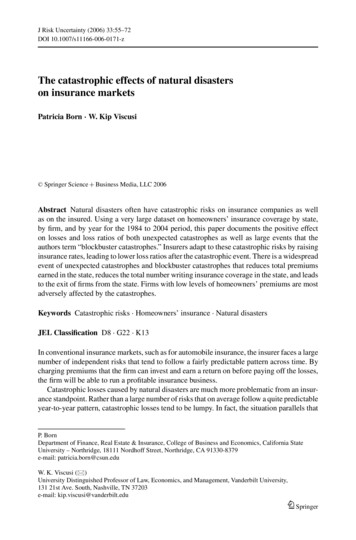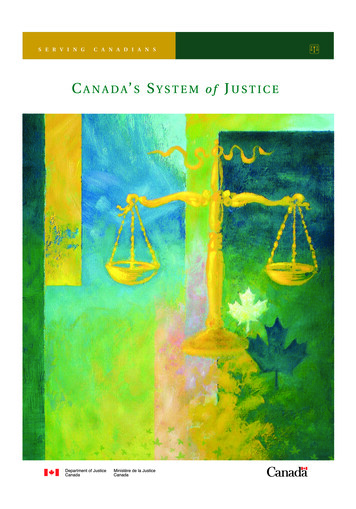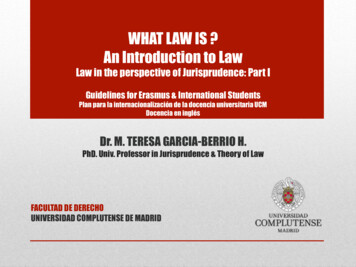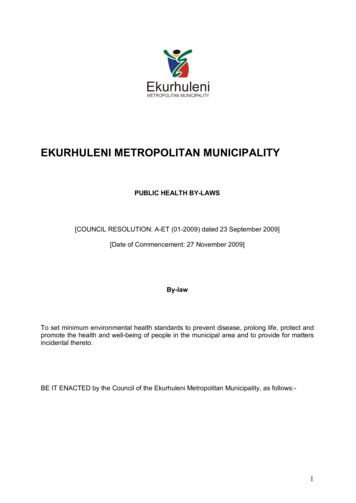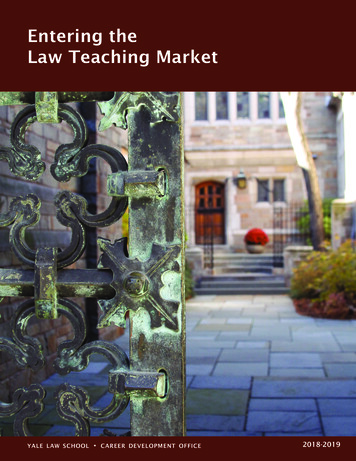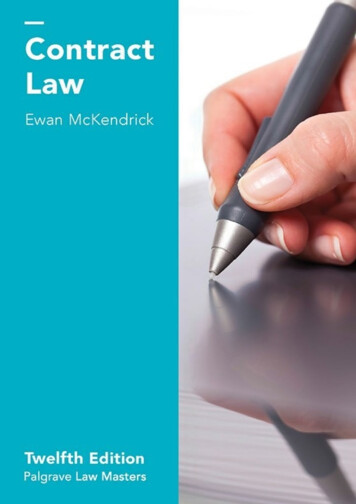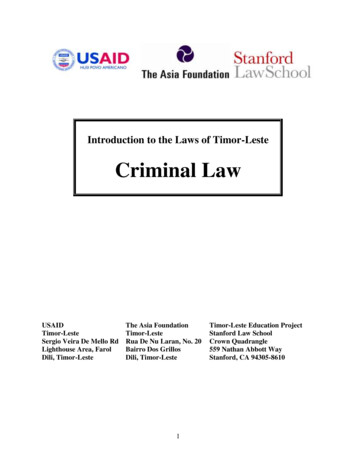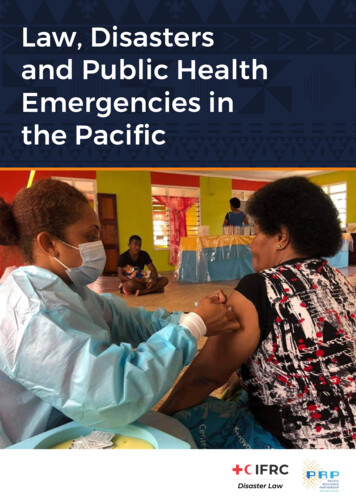
Transcription
Law, Disastersand Public HealthEmergencies inthe Pacific
International Federation of Red Cross and Red Crescent Societies, Geneva, 2021Any part of this publication may be cited, copied, translated into other languages or adapted to meet local needswithout prior permission from the International Federation of Red Cross and Red Crescent Societies, providedthat the source is clearly stated.Cover photo: Fiji Red CrossContact us: Requests for commercial reproduction should be directed to the IFRC Secretariat:Address: Chemin des Crêts 17, Petit-Saconnex, 1209 Geneva, SwitzerlandPostal address: P.O. Box 303, 1211 Geneva 19, SwitzerlandT 41 (0)22 730 42 22 F 41 (0)22 730 42 00 E disaster.law@ifrc.org W disasterlaw.ifrc.org2
IFRC Disaster LawIFRC Disaster Law and National Red Cross and Red Crescent Societies have 20 years of experience inproviding technical advice to governments to strengthen disaster risk governance through laws andpolicies, and in building the capacity of domestic stakeholders on disaster law.To date, we have provided support to more than 40 countries to strengthen their disaster laws andwe have conducted disaster law activities in more than 90 countries. IFRC Disaster Law is also aleader in conducting research and developing innovative guidance on domestic best practice. It hasproduced four key guidance documents: the Guidelines for the Domestic Facilitation and Regulation of International Disaster Relief and InitialRecovery Assistance (commonly known as the IDRL Guidelines); the Checklist on Law and Disaster Risk Reduction (the DRR Checklist); the Checklist on Law and Disaster Preparedness and Response (the DPR Checklist); and the Guidance on Law and Public Health Emergency Preparedness and Response (Pilot Version).The first three guidance documents have been endorsed by the states parties to the GenevaConventions and the components of the Red Cross and Red Crescent Movement by resolutions ofthe International Conference of the Red Cross and Red Crescent. They are used by disaster-relatedstakeholders as a benchmark for evaluating and strengthening domestic disaster laws.IFRC Disaster Law has also produced numerous implementation tools to facilitate the strengtheningof domestic legal frameworks. The work of IFRC Disaster Law is made possible by the generoussupport of our partners, who include academic institutions, law firms, governmental authorities andNational Red Cross and Red Crescent Societies.disasterlaw.ifrc.orgPacific Resilience PartnershipTechnical Working Group on Risk GovernanceThe Pacific Resilience Partnership Technical Working Group on Risk Governance brings togetherPacific Island risk management practitioners, law and policy makers as well as regional partners. Theworking groups seeks strengthened risk governance for resilient development in the Pacific throughstrengthening regional collaboration, promoting best practices, providing guidance for nationalpolicy and legislation development processes and facilitating exchange of lessons learned with aninitial focus on the development and implementation of climate smart disaster risk managementlegal nce-partnership/3
AcknowledgementsThis report was commissioned by IFRC Disaster Law. With thanks to the primary research team,comprising Professor John Hopkins,i Finau Leveni,ii Laura Braid, Talia Siataga and Billy Hanseniii whoundertook a desktop study examining the legal and policy frameworks around health and otherdisasters around a series of questions framed within the context of the IFRC’s global project on Lawand Public Health Emergency Preparedness and Response: Lessons from the Covid-19 Pandemic.ivThanks are owed to those from partner organisations who reviewed the report and providedcomments during the consultation and finalisation of the report. This includes members of thePacific Resilience Partnership Technical Working Group on Risk Governance, including countryrepresentatives from Fiji, Papua New Guinea, Samoa, Solomon Islands, Marshall Islands, Tonga,Tuvalu and Vanuatu. Also acknowledging support from the IFRC Disaster Law Pacific team for the finalreview of the report, Hanna Butler, Gabrielle Emery, Meiapo Faasau and Padmini Nayagam.Further thanks are to our donors; Australian Red Cross, Australian Government Departmentof Foreign Affairs and the German Government Federal Ministry for Economic Cooperationand Development.4
ForewordUnderpinning all aspects of the COVID-19response around the world are laws andpolicies. Laws and policies have enabled statesof emergencies to be declared, lockdowns tobe imposed, and more recently, expeditedvaccine approval.In many countries, old laws and contingenciesplans have been dusted off, sometimes provingto be outdated or inadequate, requiring the rapiddevelopment of new laws and regulations. Neverbefore have so many laws been made in sucha short time.Law and policy form the foundation of disasterrisk management, regulating how, when and bywhom emergency response activities are carriedout. Without a strong legal base, preparednessand response activities can be uncoordinatedand ineffective, often delaying urgent help to thepeople that need it most.Domestic legal preparedness for disastersneeds to include and integrate public healthemergencies to best help keep communities safe,protects the most vulnerable and save lives.Our new report, Law, Disasters and PublicHealth Emergencies in the Pacific looks atthe intersection of public health emergenciesand conventional disaster risk managementapproaches in the Pacific.The Pacific is home to many natural hazardsand the harsh reality of climate change, andtherefore home to many experienced nationaland local responders with tried and testeddisaster management systems. Many of thesesystems were put to the test during COVID-19,not only in response to the pandemic but alsofor various weather-related disasters during thisperiod. This experience demonstrated the needfor integrated and well-coordinated responses tomultiple hazards.These challenges and the identified need tostrengthen health systems across the Pacificregion meant that the consequences of COVID-19outbreaks were potentially disastrous. Thememory of the 1918 flu epidemic in the region,when over 20 per cent of the Samoan populationdied, remains strong, and the Samoan measlesoutbreak in 2020 is a recent reminder of theconsequences of disease spreading in anunvaccinated vulnerable population.For this reason, states across the Pacific region,including New Zealand and Australia, adopteda strategy of isolation and elimination. This wasin direct contrast to the rest of the world wholargely adopted a policy of disease management.This policy was made possible by the oceanicnature of these states and early decisionsto close the international borders, in somecases completely.As a result of this early action and intentionalpolicy decisions, most of the Pacific remainedfree of COVID-19 for a long period. During thisperiod, the region and the states studied did notexperience the virus in terms of a health crisis.Instead, this prolonged isolation caused severesocial and economic impacts, requiring an all ofgovernment and society approach.This situation has now changed in some Pacificcountries, showing the consequences of adoptinga disease management approach in a regionsuch as the Pacific and providing evidence forthe validity of the region’s unique ‘isolate andeliminate’ strategy.The Pacific’s response to COVID-19 was resilient,with a sense of solidarity and ingenuity, and asa result, there are many lessons to learn fromtheir experiences both in terms of multi-hazardresponse and how that has been formalised inrelevant laws, policies and plans.However, the experiences have also exposedsignificant weaknesses and gaps, both in terms ofpolicy and practice. If the COVID-19 pandemic hastaught us anything, it is the importance of beingready for the challenges a pandemic creates. Partof this requires effective public health emergencylaw and policy, as part of a wider disasterlaw framework.When Pacific governments emerge from thecurrent crisis, many will wish to draw on theexperience of the COVID-19 pandemic to reviewand strengthen their domestic legal frameworks.As the global leader in disaster law, with 20 yearsof experience developing and implementinglaw and policy, we stand ready to work withPacific National Red Cross Societies, the PacificResilience Partnership and Pacific governmentsto prevent and reduce the impact of disastersand protect the most vulnerable.Katie GreenwoodHead of Delegation, IFRC Country ClusterDelegation for the Pacific5
Executive SummaryLaw, Disasters and Public Health Emergencies inthe Pacific, analyses laws, policies, and to theextent possible, practice between the level ofintegration and cohesion between disaster riskmanagement and public health emergencyframeworks across eight Pacific countries; Fiji,Papua New Guinea, Samoa, Solomon Islands,Marshall Islands, Tonga, Tuvalu, and Vanuatu.The research was carried out in partnershipwith the Pacific Resilience Partnership (PRP)Technical Working Group on Risk Governancevand the International Federation of Red Crossand Red Crescent Societies (IFRC).The report provides regional analysis, countrylevel mappings, and recommendationson how to future-proof disaster lawframeworks to better integrate public healthemergency measures.The main frame for reference and assessmentfor the research is the Bangkok Principlesfor the implementation of the health aspectsof the Sendai Framework for Disaster RiskReduction (the Bangkok Principles). TheBangkok Principles provide a blueprint forintegrating health and disaster managementplanning, policy, and law. They emphasize thecommonalities between health risks (biologicalhazards) and natural hazards, and the needfor them to be addressed through disaster riskmanagement approaches, risk assessments,surveillance, and early warning systems.The report finds that, like other countriesaround the world, there is a level of formaldisconnect between public health emergencyand traditional disaster risk management inthe Pacific Island states studied. However, theresearch also demonstrates that Pacific Islandstates have proved adept at responding to thevery different nature of COVID-19 in the region.In many cases, Pacific Island states haveeffectively coordinated responses regardlessof gaps in the relevant legal frameworks.Law, Disasters and Public Health Emergenciesin the Pacific provides comments on thefuture direction of law and public healthemergencies and that integration betweenhealth and the disaster risk management law6and policy framework appears higher than theglobal average.However, the continued use of parallelplanning and response structures needs tobe examined. This is particularly in the lightof COVID-19, where the biological hazard,although requiring a significant role for thehealth sector, has largely led to an economicand social disaster in the Pacific context,requiring a coordinated logistical, economicand social response.As witnessed in the region and globally, everysector of society has been impacted by thispandemic. Often the pandemic has playedout against the dual impact of other hazardevents, such as Tropical Cyclone Harold, whichdrove a destructive path through the Pacificat the outset of COVID-19 in 2020. This hasfurther highlighted the need for multi-hazardapproaches to be entrenched in domesticpreparedness and response systems, includingan all of government – and all of society –coordination mechanisms.This calls into question the need for greaterclarity and leadership roles for disaster riskmanagement practitioners in the prevention,preparedness and responses to publichealth emergencies. While there are somelimitations in the Pacific, there are also manyexamples of good and innovative practiceswhich can inspire as we look to strengthenlegal preparedness for future disasters in thePacific – be they geological, meteorologicalor biological.Regional, national and local partners acrossthe Pacific are encouraged to use this Report’sfindings and recommendations to supportmore inclusive and coherent approachesin laws and policies for disaster eventsin the region.
7
Key Findings The majority of Pacific Island states examined, formally operate hybrid frameworks(frameworks mainly based on public health emergency legislation, but with disaster riskmanagement and/or SoE laws supporting and supplementing that legislation to a lesser orgreater extent). In practice, however, most have a separate and parallel structure for biological hazards/health risks in contrast to hazards that are geological or meteorological in nature. The disaster risk management framework plays a larger role in Pacific hybrid frameworksthan in other global examples. The existence of hybrid frameworks did allow states to adapt to the very differentrequirements of the global pandemic in the Pacific. A role for the National Disaster Management Office is common in the health emergencystructure in the Pacific. This proved vital in allowing multi-hazard responses to cope withthe pandemic. Most Pacific Island states appear to have developed models to allow some level ofintegration of health and other disasters, beyond that seen in many non-Pacific models(and in metropolitan Pacific states). The regional framework played a key role in the Pacific response through the PacificHumanitarian Pathway – COVID-19. It showed the potential for more formalised regionalapproaches to coordination for disasters and emergencies in the region. The legal gap around the realities of COVID-19 meant that the legal frameworks existing inalmost all the Pacific Island states studied were exposed. This resulted in new emergency regulations and long states of exception (emergency/disaster, etc.) in many states. This normalisation of the exceptional has led inexorably to executive creep and thenormalisation of exceptional measures. This has created wider constitutional issues inmany Pacific Island states. Without culturally relevant checks and balances, some states risk living in a semipermanent state of exception and emergency given the likelihood of continued crisis in thewake of climate change and future pathogen driven disasters.8
Key Recommendations The creation of single statute disaster law frameworks (to include public healthemergencies) in those states where no such statutory framework exists. The creation of clear statutory frameworks around public health emergencies (identified assuch) as part of a wider disaster law framework to address the regulatory needs of publichealth emergencies. Coherence between legal frameworks on disaster preparedness, response and recovery,across all hazards, including public health emergencies The streamlining of disaster law and public health emergency frameworks, with anemphasis on local relevance, simplicity and clarity of operation. The creation of legal frameworks to address long duration disasters, while complying withthe rule of law and democratic principles, without the need to utilise long term statesof exception. Explicit and improved integration of NDMOs into the public health emergencylaw framework The establishment of regional/international legal arrangements around logisticalcooperation in national, regional and global disasters leading to long term isolation forPacific Island states. Greater consideration of the role and protection of vulnerable groups (and individuals)within Pacific disaster law frameworks, particularly in relation to long term disasters (suchas public health emergencies). The further development and formalisation of regionally led disaster and public healthcooperation mechanisms under the Pacific Forum’s Boe Declaration.9
MethodologyA desktop study examining the legal and policyframeworks around health and other disasterswas undertaken.The assessment questions for this wereframed within the context of the IFRC’s globalresearch, Laws and Public Health EmergencyPreparedness and Response: Lessons from theCOVID-19 Pandemic.viEight Pacific Island states werechosen for in-depth analysis: Fiji Papua New Guinea Samoa Solomon Islands Marshall Islands Tonga Tuvalu VanuatuThese reflect the current members ofthe Technical Working Group on RiskGovernance (TWG) under the PacificResilience Partnership.vii10Unfortunately, COVID-19 restrictions in thePacific meant that fieldwork was impossiblebut a series of interviews were conductedwith Pacific governments (primarily NationalDisaster Management Officers, NDMOS),other relevant practitioners and NGOrepresentatives, in addition to a virtual PacificRisk Governance technical working groupmeeting to provide feedback on draft nationalreports. The limited nature of the interactionsbetween the research team and practitionersmeans that the overall depth is not at thelevel that the research team would like tohave achieved.Nevertheless, the report presents eightnational studies examining both the legal andpolicy frameworks which apply in each of thestates studied and a series of policy focussedsummaries on the practical implementationof multi-sectoral responses to healthemergencies and other natural disasters. Aseparate chapter examines the operation ofregional cooperation mechanisms in multihazard and multi-sector disaster response,with a particular focus on the currentCOVID-19 crisis.Based on these reports, drafts of which werecirculated to the government departments andagencies concerned, the final section of thereport provides a brief overview and analysisof the state of integration between health anddisaster law frameworks/institutions.
Laws, Disasters andPublic Health Emergencies:An Overview of Institutional FrameworksLaws and governance systems for naturalhazards and biological hazards, usually styledas public health emergencies have traditionallyoperated independently from each other.Although clearly connected, there has beena tendency to treat these two aspects ofdisaster risk management differently. Thereare a number of reasons for this, not least ofwhich is that on a daily basis the health systemperforms a role that is far larger, and morecentral, than that of disaster risk reduction andmanagement agencies. The size and centralityof health systems require a significantbureaucracy to manage the business-as-usualoperations they undertake. Agencies chargedwith disaster risk reduction and disaster riskmanagement , by contrast, tend to be smallerand seen as less central to the operationof the state, only rising to prominence inthe event of a disaster. This disparity in sizeand importance has consequences for theirintegration in the event of disasters.Firstly, the size and importance of healthsystems mean that they develop a bureaucracycapable of managing their operations that,while central to response, can be disconnectedfrom the wide disaster management process.In addition, the institutions of disaster riskreduction and disaster risk management beingside-lined by the behemoth of health even indisaster situations. This domestic disparity andproblems of domestic administrative politicsare exacerbated at the international level byparallel governance systems. Internationalhealth governance (including public healthemergency) is largely managed throughthe structures and practices of the WorldHealth Organisation (WHO) while disastersand emergencies sit within the frameworkof the UN Office of Disaster Risk Reduction(UNDRR) and in practical response terms,that of UN Office for the Co-ordination ofHumanitarian Affairs.Although there is potential for significantoverlap between the responsibilities of thesetwo international agencies, in practice UNDRRhas largely concerned itself with naturalhazards leaving the WHO to manage publichealth emergencies. The legal consequenceof this sees the disaster risk reduction sectorfocus primarily upon the Sendai Frameworkfor Disaster Risk Reduction,viii action whichprovides an international touchstone forall hazard disaster management and riskreduction, while the public health sector looksto the International Health Regulations (IHR),the key international legal document for themanagement of public health emergencies.ixWhile the IHR, unlike Sendai, is a formallybinding treaty it is far narrower in its scopefocussing purely upon the international spreadof disease. In addition, such restrictionsmust be explicitly charged with avoidingunnecessary interference with internationaltraffic and trade.x By contrast, Sendai, althougha soft-law instrument has a far broader anddeeper remit. As well as being applicable todisasters caused by natural or man-madehazards, as well as related environmental,technological and biological hazards and risksthe framework applies to all disasters, bothdomestic and international.xii This divisionbetween the WHO and UNDRR has practicalconsequences as few of those who work withinpublic health emergency legal frameworkseven have knowledge of the Sendai Frameworkand the wider landscape of disaster law inwhich it sits.11
The challenges posedby the operationof parallel legalframeworks aroundthe managementof public healthemergencies, incontrast to naturalhazards (caused bymeteorological andgeological events)have increasinglybeen recognised atthe international level. As a result, the SendaiFramework makes specific references to healthand its importance throughout the document,in contrast to the Hyogo Framework for Actionthat preceded it. Priority three (i) in particularemphasises the need to;“. enhance the resilience of nationalhealth systems, including byintegrating disaster risk managementinto primary, secondary and tertiaryhealth care, especially at the locallevel; developing the capacity ofhealth workers in understandingdisaster risk and applying andimplementing disaster riskreduction approaches in healthwork; promoting and enhancingthe training capacities in the field ofdisaster medicine; and supportingand training community healthgroups in disaster risk reductionapproaches in health programmes,in collaboration with other sectors,as well as in the implementationof the International HealthRegulations (2005) of the WorldHealth Organization”12These sentiments were put into practicethrough the adoption of the BangkokPrinciples,xiii at the International Conferenceon the Implementation of the Health Aspectsof the Sendai Framework for Disaster RiskReduction in 2016. These principles aimto address the problems created by thecontinued operation of parallel internationallegal frameworks for disasters triggeredby public health emergencies and thosedriven primarily by other hazards. As such,they provide an international framework toadvance and improve the level of co-ordinationbetween the health and disaster risk reductionsectors and encourage the integration ofpublic health emergencies into the widerframework of disaster risk management (andvice versa). These seven principles, providea framework for improved coordination ofefforts to reduce risk from biological hazardsand call for an inter-operable, multi-sectoralapproach to promote systematic cooperation,integration and, ultimately, coherence betweendisaster and health risk management.xiv Thesesentiments are to be welcomed and as thecurrent international legal document on thesubject they form the basis of the followinganalysis. However, as the following makesclear, it is not, as yet, obvious that theseprinciples are having much specific traction.
Contextualising the COVID-19Response in the PacificCOVID-19 has played out very differently inthe Pacific, thus far, to most other parts of theglobe as most Pacific Island states (with theexceptions of Fiji, Papua New Guinea and nowFrench Polynesiaxv) have remained, largely,COVID-19 free. For most of the Pacific, theCOVID-19 disaster has thus primarily been aneconomic and social one. As a region facinghuge logistical challenges, hazards in this partof the world often play out quite differently.This tyranny of distance in the Blue Pacificmeans that logistics always plays a significantrole in any disaster response.For this reason, a global hazard often leads toquite a different form of disaster response inthe Pacific region. This is particularly true formulti-hazard disasters and has been clearlyexposed in the recent COVID-19 pandemic. Inthis latter example, the health emergency hasdriven a series of other consequences, manyof which are far removed from the healthaspects of the disaster. These have includedsevere economic hardship, populationsstranded outside the state, severely limitedinternal movement, lack of basic suppliesand an inability of citizens of these statesto undertake their usual work overseas(with the subsequent loss of remittances).Mitigating these impacts has required thedevelopment of legal frameworks far outsidethose expected for health emergencies. Manystates have struggled with their existing legalframeworks to implement these responsemechanisms, however, the high level ofintegration experienced in a number of Pacificstate disaster law mechanisms has allowedfor a level of co-ordinated response acrossgovernment and non-government that has notalways been evident in other parts of the worldand even in the metropolitan states in thePacific region.and multi hazard approach to hazards haspredominantly stood the island states in goodstead and has provided them the flexibilityto incorporate public health emergencieswhen faced with multi-hazard and healthemergencies in the modern era.This has seen administrative agenciesoperating across sectors in a way that has notalways been experienced outside the PacificIsland states. For example, although NewZealand has been lauded for its strong politicalresponse to COVID-19, the administrative gapleft by no overall co-ordinating administrationand the focus on health as the lead agencyhas, at times, led to a number of fundamentalmissteps around logistical issues relatingto managed isolation, the testing of borderworkers and the enforcement of lockdownmeasures (amongst other examples).xvi Thesefailures of horizontal co-ordination andcoherence have occurred due to a lack ofcross-sector awareness from those involvedin decision making. In Australia, similar issueshave occurred but these have been mostvisible vertically, between the levels of thefederal system. In the Pacific most island states(although not all), by contrast, do not appear tohave experienced such issues with a relativelysmooth legal implementation of desiredpolicies. That this has occurred despite thelimitations of the multi-hazard legal frameworkin many states leads to the conclusion thatthe relatively integrated institutional networksthat exist have played a role. It is also perhapsnotable that Papua New Guinea’s struggleswith the second wave of coronavirus arein the context of a disaster law frameworkthat is possibly the least integrated and leastdeveloped in the region.xviiA key feature of these positive experiencesis the embedding of the NDMO planning andsystems for all-hazard planning. Despite this,the tendency to silo and inadequately integratehealth aspects into the disaster managementarchitecture remains an issue in a numberof states in the Pacific. However, the holistic13
Working Together as a RegionThe economic and social impacts of theCOVID-19 response are such that few nationstates can hope to mitigate its impact withoutinternational cooperation. This is increasinglytrue of disasters as a whole, particularly asthey become increasingly multi-hazard. Thepandemic of 2020/2021 is merely one exampleof this but its severity and impact on the Pacificstates led to a level of regional cooperationbeyond that normally experienced. Despitestrong rhetoric on regional cooperationfor disaster response, prior to COVID-19,practical developments in this regard hadbeen disappointingly slow. However, in 2020one notable regional initiative was launchedto provide trans-regional support in the wakeof COVID-19.In March, the Pacific Island Forum launchedthe Pacific Humanitarian Pathway on COVID-19(‘PHP-C’) which aimed to expedite requestsfor medical supplies, technical expertise, andhumanitarian assistance made by Forummembers.xviii The PHP-C was designed tocomplement and coordinate existing bi-lateralrelationships with development partnersand regional or international humanitarianorganisations rather than replace them.However, the swift development of regionalprotocols around customs, biosecurity,immigration, the repatriation of foreignnationals and diplomatic clearances foraircraft and ships transporting medical orhumanitarian assistance was a significantachievement in a field which has traditionallyrequired individual state protocols and whereno standard regional SOPs currently exist.xixImplementation of the PHP-C was overseenby a Forum Ministerial Action group with aRegional Task Force to oversee its operation.This was a significant development given thetraditional emphasis on national sovereigntyin the field of Pacific disaster management.The PHP-C thus represented an importantshift in practical efforts to tackle disaster riskmanagement as a region, in line with the BoeDeclaration and the Action Plan published in2019.xx It is also significant that the responsewas Pacific Island-led, demonstrating thecapacity for cooperation outside of the ambitof development partners (although the14delivery of some PHP-C initiatives relied heavilyupon external assistance).One issue of particular significance for thePacific Island states was the suspensionof commercial air services, which createdsignificant challenges for supply chainsacross the region. This gap was filled by theestablishment of the Pacific Humanitarian AirService under the PHP-C which ensured thatcommercial flight suspensions did not impedethe delivery of urgently required personnel,equipment and supplies.These regional cooperation mechanismsclearly
and the International Federation of Red Cross and Red Crescent Societies (IFRC). The report provides regional analysis, country-level mappings, and recommendations on how to future-proof disaster law frameworks to better integrate public health emergency measures. The main frame for reference and assessment for the research is the Bangkok .

